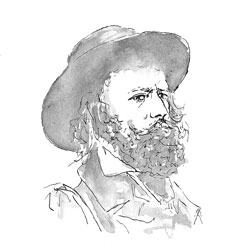Music and Meaning (1): Tennyson’s Aestheticism
In 1830, Tennyson's friend Arthur Hallam (whose death would later be the subject of In Memoriam) wrote an important review of Tennyson's first independent anthology of poetry, Poems, Chiefly Lyrical. In that review, Arthur contrasted his friend with Wordsworth and related him to Shelley and Keats, characterising Tennyson as a poet of 'sensation' and Wordsworth as a poet of 'reflection'.
The Cambridge-based literary critic Angela Leighton suggests that Hallam's review provides 'the key' to understanding Tennyson's 'unofficial reputation' as 'the most powerful, undeclared voice of English aestheticism'. Aestheticism was an artistic movement spearheaded in Victorian England by artists like Dante Gabriel Rossetti, who created the black and white illustration for Tennyson's poem 'The Lady of Shalott' that you can observe by following this web-link [http://www.artmagick.com/images/content/rossetti/hi/rossetti20.jpg]
What is striking about Tennyson's 'unofficial' connection with this movement is that 'Aesthetic' artists like Oscar Wilde and Dante Gabriel Rossetti generally believed that it was art's function to provide refined sensuous pleasure, as opposed to conveying the sort of moral or sentimental message that we might expect Queen Victoria's Poet Laureate to convey, and which Tennyson to some extent did convey.
As you work your way through the 'Music and Meaning' resources, you will come across some remarks that Tennyson's friend Hallam made about the 'sensuousness' of his poetry, and you will discover what some important literary critics have had to say about the relationship between Tennyson's poetry and music. As you read the extracts from In Memoriam, 'The Lotus-Eaters' and all the other famous poems by Tennyson that you'll be encountering over the next few pages, think about whether you agree with Arthur Hallam's idea that Tennyson is a 'Poet of Sensation'.
As well as Tennyson's poetry and ideas about Tennyson's poetry, you'll also encounter lots of pieces of music and artworks, like this song by Loreena McKennit [http://www.youtube.com/watch?v=QMazwBCa9yU&feature=related], this illustration by Dante Gabriel Rossetti mentioned above [http://www.artmagick.com/images/content/rossetti/hi/rossetti20.jpg] and this very famous painting by John William Waterhouse [http://commons.wikimedia.org/wiki/Image:JWW_TheLadyOfShallot_1888.jpg]. All three of these artworks are called 'The Lady of Shalott' and are inspired by one of Tennyson's poems, which also has this title. Search for a copy of Tennyson's poem on the internet or in any modern collection of his poetry and think about how reading it makes you feel. Do this song, this illustration and this painting make you feel the same way as you do when you are reading the poem, or do they make you feel something different? Artists belonging to the Aesthetic movement are generally interested in creating 'synaesthetic' effects, which means that they enjoy making or highlighting correspondences between words, colours and music. How do you think this relates to Tennyson?
Next: by thinking about (and listening to) the way in which Tennyson read his poetry, we'll start considering some possible answers to these questions.
[Go on to Music and Meaning (2): Tennyson's Voice and 'Declamation']
